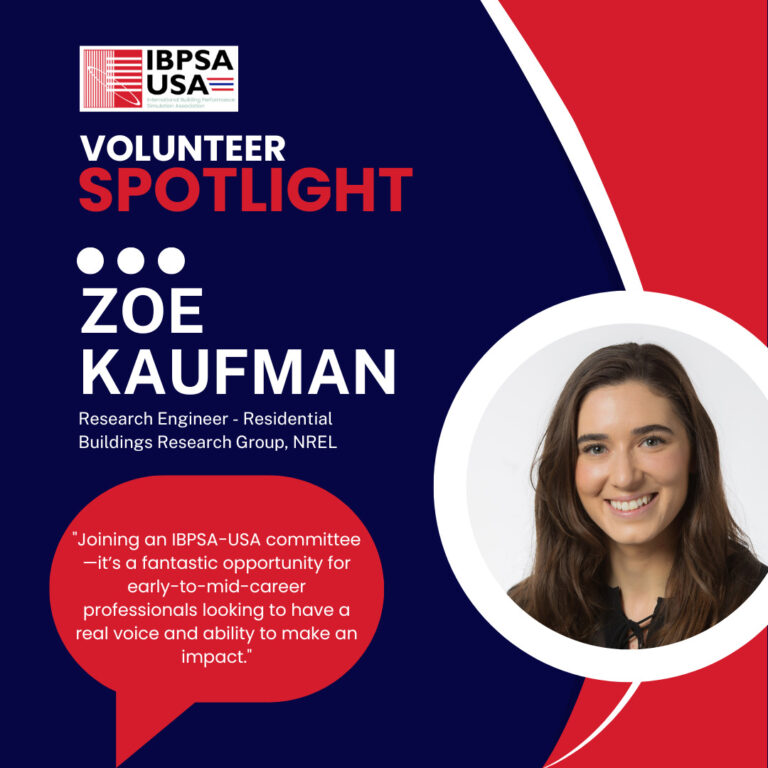Zoe Kaufman

Zoe Kaufman is a Research Engineer in the Residential Buildings Research Group at NREL. Zoe’s experience and interests range from high-performance, affordable multifamily building consulting to building-science field experimentation and validation using hygrothermal simulation. She values the marriage of building performance modeling and field experience to arrive at practical, impactful solutions for healthy, durable, and decarbonized buildings.
"I wanted to be in the know [and] be informed."
How long have you been a member of IBPSA-USA?
I’ve been an IBPSA member since my days in consulting, and involved as a volunteer since transitioning to research.
Why did you join IBPSA-USA?
As I transitioned into research, I became more curious about the building-simulation community and ongoing evolution. I wanted to be in the know, be informed as to what was coming down the pipeline, and how others were leveraging building-simulation tools to improve or better represent the built environment.
What’s your favorite part of being a member of IBPSA-USA?
I get to have frequent conversations with incredibly smart people who are working at the cutting edge of building technology and simulation. These conversations can be both formal and informal, and you never know what you’ll learn by either showing up to an IBPSA-USA event or participating in a committee or working group. As the chair of the Ask A Modeler working group, I have an excuse to connect with experts in the field about an almost infinitely wide range of interesting topics, such as adaptive comfort and biomimicry (peep the upcoming column!).
Can you describe the volunteer work you do with IBPSA-USA?
I started out as a member of the Research Committee and soon was elected to be in charge of the Ask A Modeler monthly advice column. In this role, I help ensure that we publish a unique, compelling piece each month from the perspective of an established expert. I had been passionate about this column from the beginning and was given a voice and responsibility, which showed that I was trusted and valuable. That’s the thing about joining an IBPSA-USA committee—it’s a fantastic opportunity for early-to-mid-career professionals looking to have a real voice and ability to make an impact. The committees and working groups are welcoming and open to creativity and promising leadership.
How did you get involved with this volunteer work?
To be honest, I can’t remember how I initially found out about IBPSA-USA’s committees, but it might have been from a newsletter. The opportunities and focuses of each committee were laid out clearly, and I was welcomed as a new member immediately. This made it easy to continue attending meetings and slowly take on more responsibility.
To someone who is interested in participating in IBPSA-USA, do you have any words of encouragement?
Yes—just try it out! We don’t bite! You are welcome to join a virtual meeting to determine whether a particular group is right for you. We always appreciate new perspectives and ideas. And if you decide a certain group is not your jam, we won’t be offended if you decide to dedicate your time elsewhere. You may just discover you have a skill that can be applied here, or you may discover an avenue to further develop a skill you’d like to hone.
What advice would you give to someone who wants to enter the field of building performance simulation?
I believe that step 1 is to simply download a relatively accessible program, such as BEopt, and start poking around. For example, try to model your own home or dwelling unit. You’ll quickly be able to identify where your knowledge gaps are, and then you can pursue a deeper understanding by either asking others or checking forums like Unmet Hours (or attending an IBPSA Mixa event). BPS can seem impenetrable to those who have never taken the plunge, but I highly recommend just giving it a shot.
Fun fact that people probably don’t know about you!
When I’m not puzzling over buildings, I’m usually upside down doing handstands.









